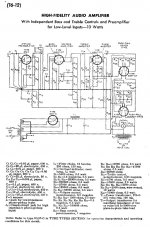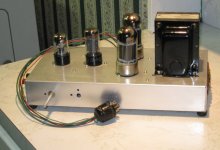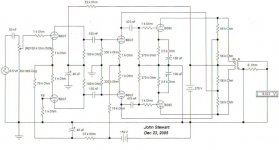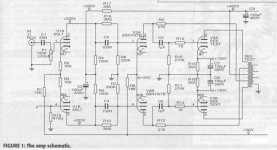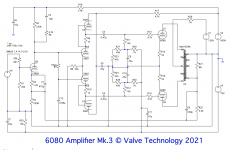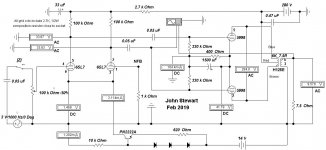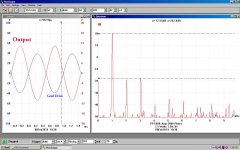the measure 295v on the plates of the 6as7's and something like 110v on the cathode.
That is Vp of 185V, which is a pretty common and good operating point for class-A 6as7 with a load of 2.5k per triode.
build the amp as it is drawn with the only change being cathode bias twin 1k per side and go and it works and sounds great. i changed the opt trans on the test amp to be a much better sounding utc 2.5k and it sounds great.
In that case you have something that can be worked with.
It is good you switched to cathode bias, so now your plate isn't seeing all 355V(as that cathode resistor has to be dropping over 100V). So it may not launch now, but it has to be run in class AB to not exceed Pmax.
The transformer you were using was the other concern. If you switched to a 2.5k plate-to-plate for a paralleled pair that is a much better match than your original transformer. And it probably has a much better DCR as well.
For your distortion issue.
Make sure your driver can deliver the voltage needed. It will take a lot of grid voltage for your output stage to reach Vgk 0V.
For class A-B you will need to have your cathode resistor(s) bypassed with a capacitor. And adding a little NFB may be benificial as far as distortion goes, but you will need some extra gain to spare.
If you want class-A that plate voltage is going to have to come down to about 185-190V (meaning aprox 290V supply) with an idle current of about 60mA per triode. It will reqire less grid drive voltage and overall you should have quite a bit less distortion.
Make sure your driver can deliver the voltage needed. It will take a lot of grid voltage for your output stage to reach Vgk 0V.
For class A-B you will need to have your cathode resistor(s) bypassed with a capacitor. And adding a little NFB may be benificial as far as distortion goes, but you will need some extra gain to spare.
If you want class-A that plate voltage is going to have to come down to about 185-190V (meaning aprox 290V supply) with an idle current of about 60mA per triode. It will reqire less grid drive voltage and overall you should have quite a bit less distortion.
Hi.desperateaudio said:............... build the amp as it is drawn with the only change being cathode bias twin 1k per side and go and it works and sounds great. ..........
What arrangement do you have on the grid now? Does the TX centre tap go to ground or as you had it in the original diagram? How have you parallelled the sections of the 6080?
Andy
distortion is gone sorry for not adding that. problem was a back test speaker not the amp.
the IT secondary is going to ground and there is now a 1k cathode resistor per tube as opposed to fixed bias.
no grid leak resistors are used though.
Jeb-D when you say 185v you mean the dif between plate and cathode correct?
and at "60ma per triode" you mean 120ma per tube if paralleled correct?
as for parallel on the 6080 i just tied them together with 1k stoppers per grid and a 47 ohm between the plates tied to one side with the power just for a little balance. cathodes tied together with a 1k dropping to ground.
keep in mind guys i have a test version running as stated above with 355v on the plate now for 11.5 hours 5.5 striaght with zero issues
the IT secondary is going to ground and there is now a 1k cathode resistor per tube as opposed to fixed bias.
no grid leak resistors are used though.
Jeb-D when you say 185v you mean the dif between plate and cathode correct?
and at "60ma per triode" you mean 120ma per tube if paralleled correct?
as for parallel on the 6080 i just tied them together with 1k stoppers per grid and a 47 ohm between the plates tied to one side with the power just for a little balance. cathodes tied together with a 1k dropping to ground.
keep in mind guys i have a test version running as stated above with 355v on the plate now for 11.5 hours 5.5 striaght with zero issues
Jeb-D when you say 185v you mean the dif between plate and cathode correct?
Yes. So that will mean roughly 280V from plate to ground and 285-290V from B+ to ground. A 750ohm cathode resistor per tube will work good at this plate voltage.
and at "60ma per triode" you mean 120ma per tube if paralleled correct?
Yes
On a side note, I've never had problems paralleling these tubes when using cathode bias. Just keep it to around 22W per tube. Figure even the hotter of the two triodes will be below 13W. It will be the balance between between each side of the transformer that is important.
L-pads can be used to balance the sides of a cathode bias push pull, if you find it to be significantly out of balance. E-I core transformers can handle some imbalance.
thanks Jeb-D
on the L-pad issue your are speaking of the l-pad being attached between both pairs of the 6as7's and the wiper to ground via the resistor correct?
thanks again
on the L-pad issue your are speaking of the l-pad being attached between both pairs of the 6as7's and the wiper to ground via the resistor correct?
thanks again
on the L-pad issue your are speaking of the l-pad being attached between both pairs of the 6as7's and the wiper to ground via the resistor correct?
Yes, it sounds like you have the right idea. Instead of wiring each pairs cathode resistor to ground, wire each to opposite ends of the L-Pad. Then wiper to ground. Just remember each pairs cathode resistor will have to be bypassed by a cap to ground.
In a class-A push pull you can get away with no bypass cap if both sides share the same cathode resistor because one tube regulates the other for the most part. Leaving an almost constant voltage at the cathode when a signal is applied.
However, if you have to implement the balance circuit, you cannot share the cathode resistor between pairs, so bypass caps are needed.
There is another way to use the L-pad and still share the cathode resistor, but it wouldn't work with the input transformer configuration.
My 6080 amp in single tube PP can output 9W 2%THD with 220V B-Voltage, each 1Kohm bias resister at each cathode.
http://ja1cty.servehttp.com/6080/6080pp.png
http://ja1cty.servehttp.com/6080/6080pp.png
very nice single tube version.
I was wondering still if anyone had any comments on my input tube balanced input switch set up?
Thanks again
I was wondering still if anyone had any comments on my input tube balanced input switch set up?
Thanks again
Just stumbled across this thread searching for PPP 6AS7 circuits...
I have a pair of UTC LS33 20W line to voice coil transformers as well as a pair of Lambda 100-300v 400ma regulated power supplies. they've been stubbing my toes; time to move them all or make something useful. Big and heavy? Oh yes.
Desperateaudio- did you ever finish the amp? Did you find 600 primaries on the OPT a bit to low for your design?
-Kent
I have a pair of UTC LS33 20W line to voice coil transformers as well as a pair of Lambda 100-300v 400ma regulated power supplies. they've been stubbing my toes; time to move them all or make something useful. Big and heavy? Oh yes.
Desperateaudio- did you ever finish the amp? Did you find 600 primaries on the OPT a bit to low for your design?
-Kent
Desperateaudio- did you ever finish the amp? Did you find 600 primaries on the OPT a bit to low for your design?
My 6AS7 PP amp is described in the below URL
(sorry, written in Japanese, but you can see schematic and photos).
Data of 6080pp Stereo Amp.
I tested a low imp OPT of 968 Ohm Primary P-P). The below
lists comparison between 2K ohm vs. 968 ohm Primary P-P.
RL (P-P) ....... 2K ohm / 968 ohm
Max Power ....... 9.2W / 8.1W
THD@1KHz/1W ..... 0.89% / 0.98%
Output Waveform is shown in the below URL.
http://ja1cty.servehttp.com/6080/W-form-1Kx.jpg
Thank you for the links. Hmm, it seems like a 600 ohm primary might work for PPP 6AS7G, but I would get similar results to your 968 ohm load for PP.
Odd, how total power went down with 968 ohm, all other things being equal? I'll study your circuit.
Thanks
Odd, how total power went down with 968 ohm, all other things being equal? I'll study your circuit.
Thanks
My opinion is to use triode connect sweep tubes such as 6P36S instead.
Triode power amplifier.
"The results were more than a little disappointing. I could get 12.5 watts out of it but at 6.5 percent distortion. Even when the power was lowered to 5 watts the distortion was still 4 percent. When I connected the feedback I couldn't get the distortion below 1 percent. Oh, well, these tubes were not designed for audio service."
Triode power amplifier.
"The results were more than a little disappointing. I could get 12.5 watts out of it but at 6.5 percent distortion. Even when the power was lowered to 5 watts the distortion was still 4 percent. When I connected the feedback I couldn't get the distortion below 1 percent. Oh, well, these tubes were not designed for audio service."
Thank`s for aswer, but I have 12 (NOS) Haltron 6AS7 G tubes, then I will try to use them.- I have read a few publications in this forum where artosalo considers that the 6AS7 tube has excellent performance for AF.
Sorry, I write more or less in English, my language is Spanish.-
Best Regards
Gusmore
Sorry, I write more or less in English, my language is Spanish.-
Best Regards
Gusmore
Last edited:
Here is my kick at the PPP 6080 amp. I avoided the requirement for a brute force driver by applying boot strapping. That can be done in at least two ways. If a UL OPT is available the drive to the previous stage is easily provided by the UL taps. Otherwise a voltage divider across the OPT primary wdg works. The OPT is a special Hammond made for me.
I did a proof of concept using the UL OPT scheme. 25 watts with a 400V PS provided by a lab supply. That's pushing things a bit, but 125V in the cathode resisters & 250V on the tubes is OK.
The other cct was a simulation only, but shews that the concept is very workable. Cathode bias is a must. Or a bias servo.
All this published in Glass Audio more than 15yrs ago. On on this forum a few times.😀
Both use a two stage diff amp, so -ve 150V is also required.The cathode resisters should be something that can be heat sinked.
I did a proof of concept using the UL OPT scheme. 25 watts with a 400V PS provided by a lab supply. That's pushing things a bit, but 125V in the cathode resisters & 250V on the tubes is OK.
The other cct was a simulation only, but shews that the concept is very workable. Cathode bias is a must. Or a bias servo.
All this published in Glass Audio more than 15yrs ago. On on this forum a few times.😀
Both use a two stage diff amp, so -ve 150V is also required.The cathode resisters should be something that can be heat sinked.
Attachments
Why not connect the drivers' plate resistors directly to the other side final's plate instead of a voltage divider or UL tap?
Best regards!
Best regards!
Hi Folks,
Sorry to dig up an old grave, has anyone thought of doing this ?
i built a 6080 p-p amp about 20 years ago using a PPP EL84 output transformer (3k a-a) but with the 8 ohm output load connected across the 16 ohm output winding, giving an anode to anode impedance of 1500 ohms.
The reason for doing this was to provide a compact power amp (<10 watts) for an integrated amp.
It didn't really work because with enough feedback for error correction, overall voltage gain was too low. It would, however, drive loudspeakers.
The attached circuit was created recently, based on the Mullard 5-20 but using a single triode rather than the pentode used in the Mullard. i have only tested it under simulation so far.
Neil xx.
Sorry to dig up an old grave, has anyone thought of doing this ?
i built a 6080 p-p amp about 20 years ago using a PPP EL84 output transformer (3k a-a) but with the 8 ohm output load connected across the 16 ohm output winding, giving an anode to anode impedance of 1500 ohms.
The reason for doing this was to provide a compact power amp (<10 watts) for an integrated amp.
It didn't really work because with enough feedback for error correction, overall voltage gain was too low. It would, however, drive loudspeakers.
The attached circuit was created recently, based on the Mullard 5-20 but using a single triode rather than the pentode used in the Mullard. i have only tested it under simulation so far.
Neil xx.
Attachments
I've looked at the Mullard cct but using a 5998. Another series PS passer tube but with a somewhat higher mu than the 6AS7G/6080. Driven by a 6SL7 the performance is very good. And doesn't need a HV PS. Add a triode to the front end and done.😀
Attachments
- Home
- Amplifiers
- Tubes / Valves
- Parallel Push Pull 6AS7 or 6080
